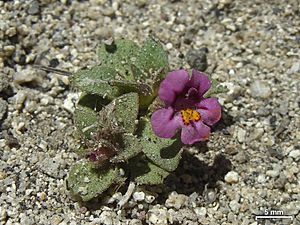Jepson's monkeyflower facts for kids
Quick facts for kids Jepson's monkeyflower |
|
|---|---|
 |
|
| Diplacus jepsonii at Mount Rose, Nevada | |
| Scientific classification | |
| Genus: |
Diplacus
|
| Species: |
jepsonii
|
| Synonyms | |
|
|
Diplacus jepsonii, also known as Jepson's monkeyflower, is a type of plant. It belongs to a group of flowers called monkeyflowers. This plant used to have a different scientific name, Mimulus nanus var. jepsonii.
Where It Grows
This special plant grows naturally in parts of California, Nevada, and Oregon. You can find it in the Sierra Nevada mountains and the southern Cascade Range.
Jepson's monkeyflower likes to grow in open spots within different types of forests. These include forests with yellow pine, red fir, and lodgepole pine trees. It grows at high places, from about 1,220 to 2,380 meters (4,000 to 7,800 feet) above sea level.
What It Looks Like
Diplacus jepsonii is an annual herb. This means it grows from a seed, flowers, produces new seeds, and then dies all in one year. It has a thin stem that stands up straight and can grow up to about 10 centimeters (4 inches) tall.
Its leaves are a purplish-green color. They can be long and narrow or more oval-shaped, growing up to 1.4 centimeters (about half an inch) long.
The flowers of Jepson's monkeyflower are a pretty pinkish-purple color. Each flower is about a centimeter (less than half an inch) long. The opening of the flower has five lobes, which are like small rounded sections. Inside, you can see bright yellow stripes and purple spots. These flowers usually bloom in May and June.
How It's Related to Other Plants
This plant can look very similar to another type of monkeyflower called Mimulus nanus. It can be tricky to tell them apart! Scientists often have to look very closely at tiny details. For example, they might check the way hairs are arranged inside the flower's opening to see the difference.

